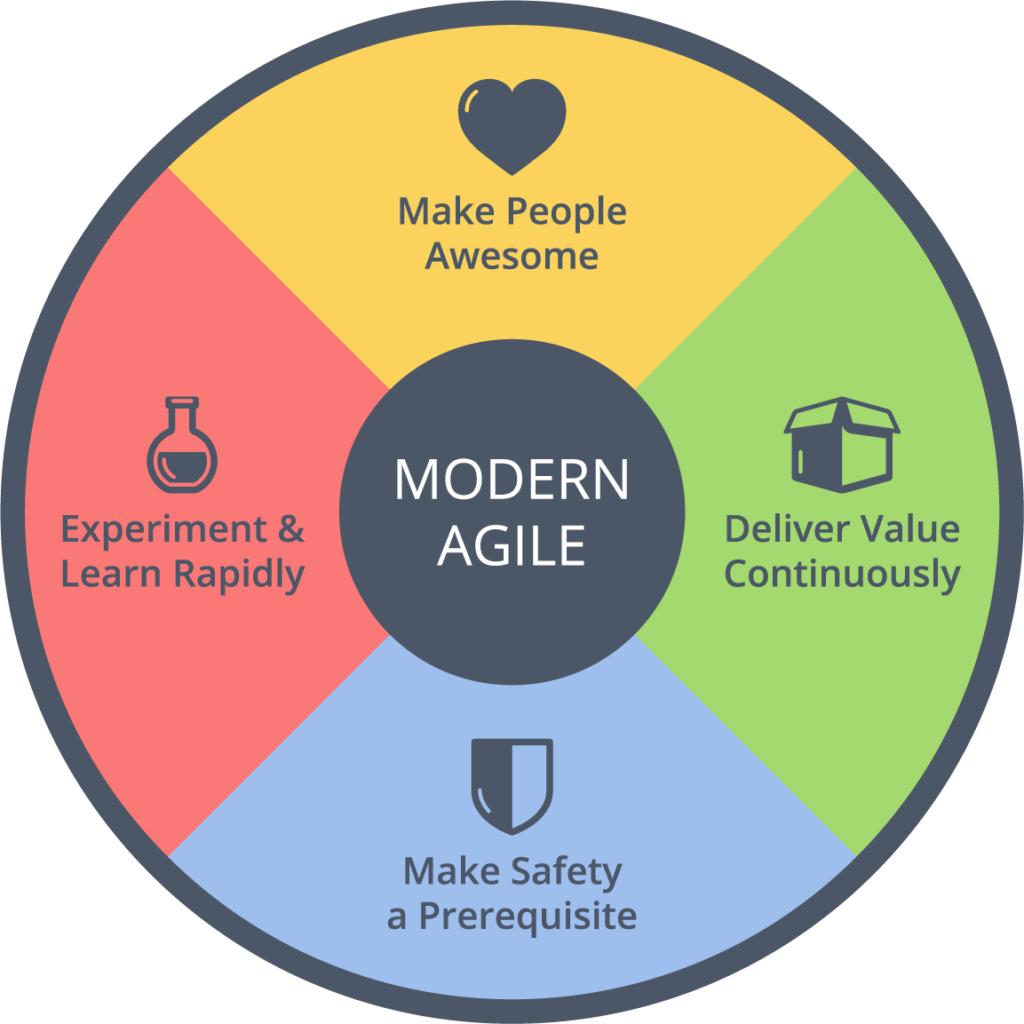 The Agile Manifesto has been around since 2001, and agile ways of working have existed long before that. So what is this thing called Modern Agile? Is the manifesto outdated and needs to be replaced? All good questions, but let’s start with taking a look on what Modern Agile is.
The Agile Manifesto has been around since 2001, and agile ways of working have existed long before that. So what is this thing called Modern Agile? Is the manifesto outdated and needs to be replaced? All good questions, but let’s start with taking a look on what Modern Agile is.
Modern Agile is made up of four guiding principles – Make People Awesome, Make Safety a Prerequisite, Experiment and Learn Rapidly, Deliver Value Continuously. And that’s it. Four principles that, when followed, can give you great speed in delivering what your customers want while having fun at work! Let’s look into what they mean.
Make Safety a Prerequisite

For me everything starts with safety. I once was at a client where I was brought in to fix this agile stuff for a couple of teams. Management had an idea that my assignment would be to straighten things out, write down some best practices and then make sure that everyone just followed them.
When I spoke to the teams they told me another story. They had tried being agile for a year, but management had effectively stopped them by constantly changing priorities and run around to teams and tell them what to do now. But the things in progress should also still be finished. “Just do this little thing, it can’t take long” was a common quote. So the teams didn’t feel safe in setting up a new way of working because management never respected the process, even though they said they would.
The first thing on my agenda then became fixing that problem with management and make them commit to some fundamental ideas and show that they trusted the teams to get things done. If I would have started with any of the other principles, we had not been able to make any progress because of the fear of management not changing their way of working.
Safety comes in many shapes. The story above is about psychological safety. Then there is physical safety, the safety of your user’s data, money, etc. This is a long list, all of it important.
Experiment and Learn Rapidly
Over 10 years ago, I was working as a CTO in a startup. The product idea we had was letting patients record how they were doing on a daily basis on their mobile (this was pre-iPhone, mind you). Have you taken your medicine? Have you exercised? How much pain are you feeling, etc, was types of questions the patient would be asked and the patient then recorded what they’ve done and how they felt. And the background to that idea is the parking lot syndrome. The parking lot syndrome is a term occasionally used in clinical research industry to describe patient’s action of filling diaries and questionnaires right before a clinic visit while waiting in the parking lot before doctor’s appointment. How easy is it to remember 6 months back? 1 month? 1 week? A day?
So how often do you stop and reflect and learn? Do you do project post-mortems (how easy is it to remember several months back in time)? Retrospectives end of sprint (how easy is it to remember weeks back in time)?
I’m a big fan of continuous improvement, and taking into consideration what Toyota Production System (a.k.a. Lean) says about it, it means that as soon as something goes wrong, you deal with it then and there. You don’t wait until the end of the sprint. And if you find something that’s working well, acknowledge that and do more of it.
The experiment is the decision you make on what to do. Give the experiment a deadline, and make sure you know how to evaluate the experiment at that deadline. Don’t be afraid to declare an experiment a failure, but then celebrate what you’ve learned.
Deliver Value Continuously
 Which kind of value do we mean? The obvious interpretation is business value, i.e. improving the product so that the users get more value out of it. And if we want to deliver that kind of value continuously, we go ahead and implement continuous delivery and then we’re done, right? Well, in a way true, but that is only part of it and also easier said than done.
Which kind of value do we mean? The obvious interpretation is business value, i.e. improving the product so that the users get more value out of it. And if we want to deliver that kind of value continuously, we go ahead and implement continuous delivery and then we’re done, right? Well, in a way true, but that is only part of it and also easier said than done.
We can also look at this principle from other angels. How can we as a team deliver value to the rest of the organisation? How can I as an individual deliver value to my team? How can I best deliver value to my team at this stand-up meeting?
Leanpub is a perfect example of how you can deliver value continuously when writing a book. As a writer, you can choose whenever you want to publish in order to get feedback on if the book is valuable. You can of course publish several versions, choose price, etc.
Another example would be that at Crisp we do open space type of conferences, and one of the rules in open space is that when in a session, if you don’t contribute or learn something, use your two feet (and go to another session). I try to apply that rule to the meetings I go to. If I don’t contribute or learn something, I try to leave. That is one way of delivering value to the others in the meeting.
It is not only about the end product. Try to look at this principle in a broader sense.
Make People Awesome
 One assignment I’ve had was working with a team that was building a system in which the teachers could create exams for their students, which they would take on computers. This saved a lot of time for the teachers because, among several things, they didn’t have to print out hundreds of exams on paper and carry that to the classroom. The system also autocorrected certain types of questions, saving a lot of the teacher’s time. We made the teachers more awesome by saving their time (and paper).
One assignment I’ve had was working with a team that was building a system in which the teachers could create exams for their students, which they would take on computers. This saved a lot of time for the teachers because, among several things, they didn’t have to print out hundreds of exams on paper and carry that to the classroom. The system also autocorrected certain types of questions, saving a lot of the teacher’s time. We made the teachers more awesome by saving their time (and paper).
Making people awesome is also something that can be viewed upon from different perspectives. One example could be how a Scrum Master coaching a team helps the team to realise how to be more awesome. In a bigger picture this principle could be interpreted as, by using our product our users become more awesome.
On a sidenote, the make people awesome principle created a little stir in twitter a couple of months back (see https://twitter.com/johannarothman/status/983347074430328833 for instance). It is easy to read this principle as “someone should make some people awesome” as in forcing them into something they may or may not want to.
Now this is of course not the intention nor the meaning of the principle. The word make should be interpreted as “create”. Here’s a link to Joshua’s explanation https://www.linkedin.com/pulse/anatomy-modern-agiles-first-principle-joshua-kerievsky/
Does Modern Agile replace the Agile Manifesto?
I do a lot of training in agile for people that is new to it, and I do exercises around both the Agile Manifesto and Modern Agile. Often enough, the simplicity of the four principles of Modern Agile resonates more with beginners.
In my opinion, the Agile Manifesto is still valid. A problem with the manifesto today is that it focuses on software. Today, agile ways of working have spread to many other lines of business. This often comes up in my classes, which makes people sometimes draw the (wrong) conclusion that agile only works in software driven products. Modern Agile does not have that problem. So yes in a way, Modern Agile is a modernization of the manifesto, but that does not mean that the manifesto is dead.
I’m very happy that the creator of Modern Agile, Joshua Kerievsky, is running a 2 day Modern Agile workshop 20-21st of September, where we deep dive into what it means to be agile today. Read more about the workshop and register here.





Excellent article. We changed up the manifesto to read ‘deliver valuable products and services that delight our customers’ rather than ‘deliver software’
This was a nice description of Modern Agile! Thanks Mikael!
Sometimes I don’t understand why people don’t speak up when confronted by something I know they strongly disagree with. I’ve often attributed this to personality, or that they postpone that feedback to a private setting. But now I am thinking that maybe, it is also sometimes because of FEAR.
Why are these called principles instead of values? What is the intention behind? Or what are the values behind these principles?
Hi Balazs,
good question! They are called principles as they are more concrete than values. The Modern Agile principles should guide you more on what to do.
In fact, in the beginning they were called “disciplines”. Have a look at https://www.industriallogic.com/blog/modern-agile/ for the article that kicked everything off.
Mikael, I would like to know more on how of this “fixing that problem with management and make them commit to some fundamental ideas and show that they trusted the teams to get things done”.
Hi Vinayak,
what would you like to know?
Hi Mikael,
Do you have any case studies of projects using Modern Agile?